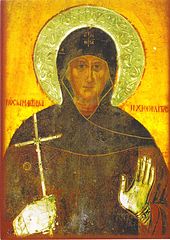
A nun is a woman who vows to dedicate her life to religious service and contemplation, typically living under vows of poverty, chastity, and obedience in the enclosure of a monastery or convent. The term is often used interchangeably with religious sisters who do take simple vows but live an active vocation of prayer and charitable work.
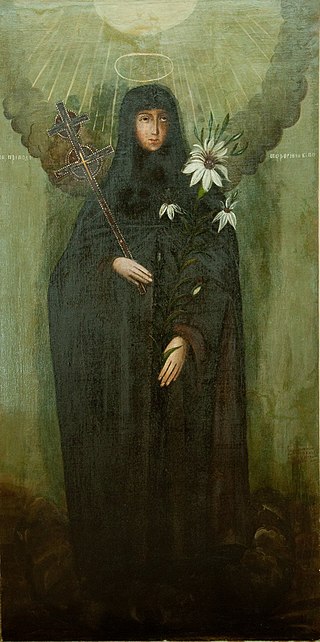
Euphrosyne of Polotsk was the granddaughter of a prince of Polotsk, Vseslav, and daughter of Prince Svyatoslav-Georgy Vseslavich. She has long been a popular saint among Orthodox devotees, particularly those in Belarus, Ukraine, and Russia with a traditional feast day of May 23. In addition, since 1984, she has been one of the 15 patron saints of Belarus, whose lives are celebrated in the Belarusian Orthodox Church, on the first Sunday after Pentecost.
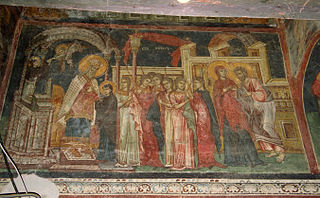
The Presentation of the Blessed Virgin Mary, known in the East as The Entry of the Most Holy Theotokos into the Temple, is a liturgical feast celebrated on November 21 by the Catholic, Eastern Orthodox, and some Anglo-Catholic Churches.
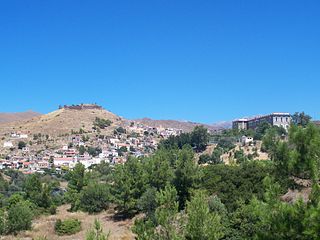
Volissos is the largest village in the northwest part of Chios, Aegean Islands, Greece. The village is situated 40 km away from the main town of Chios.

July 14 - Eastern Orthodox Church calendar - July 16
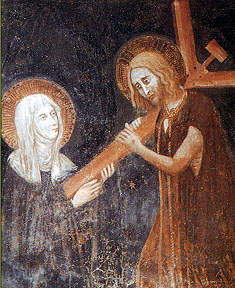
Clare of Montefalco, also called Saint Clare of the Cross, was an Augustinian nun and abbess. Before becoming a nun, Clare was a member of the Third Order of St. Francis (Secular). She was canonized by Pope Leo XIII on December 8, 1881. She differs from Clare of Assisi, a contemporary of St Francis and the founder of an order of Poor Clares.
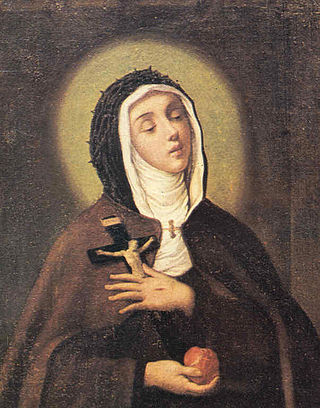
Veronica Giuliani was an Italian Capuchin Poor Clares nun and mystic. She was canonized by Pope Gregory XVI in 1839.

Marina, distinguished as Marina the Monk and also known as Marinos, Pelagia and Mary of Alexandria, was a Christian saint from part of Asian Byzantium, generally said to be present-day Lebanon. Details of the saint's life vary.
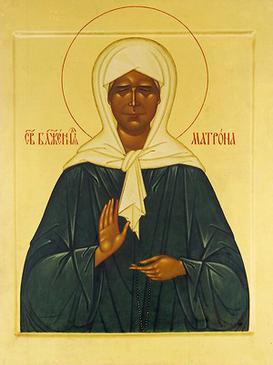
Matrona Dmitrievna Nikonova is a canonized saint of the Russian Orthodox Church who is said to have had the gifts of prophecy, spiritual vision, and healing from early childhood.

Văratec Monastery is a Romanian Orthodox women's monastery located in north-eastern part of the country, in Văratec village, Agapia Commune, Neamț County. It is situated at 12 km from Târgu Neamț and 40 km from Piatra Neamț. It is the largest community of nuns in Romania, with more than 400 nuns living there.
Glodesind (572−608) was a saint, nun, abbess, and founder of a convent in Metz, France, during the time of King Childebert II (575−596) of Austrasia. She was a member of the Carolingian nobility. When she was 11 or 12 years old, she married a young nobleman, who was arrested by the French government shortly after their wedding and executed a year later. Instead of remarrying as her family wanted, she fled to Metz and took refuge at the Church of St. Stephen. Her family gave up forcing her to marry, and she became a nun and later, the abbess of a convent that was built by her parents. She was abbess for six years until her death in 608 at the age of 30. Her feast day is 8 July.

Saint Markella or Marcella was an inhabitant of 14th century Chios who was canonized by the Greek Orthodox Church. Her feast day is celebrated on July 22.

Chiara Offreduccio, known as Clare of Assisi, was an Italian saint who was one of the first followers of Francis of Assisi.
St. Mother Irini was the Coptic Abbess of the St. Philopateer Mercurius’ Convent in Old Cairo, Egypt and an influential figure in the Coptic Christian community of Egypt.
Eustadiola (594–684) was a saint, widow, and abbess. She was born to wealthy and politically powerful parents in Bourges, France. She married due to pressure from her family, but became a widow at a young age, which gave her the financial and social independence to live what Sainted Women of the Dark Ages centuries later called a "semiretired religious life". She gave away her wealth to the poor, founded churches, monasteries, and convents, and used her wealth and influence to expand and decorate the buildings. Eustadiola was abbess of the convent she founded in Bourges, and lived as an ascetic for 70 years. Many miracles and healings were attributed to her. Her feast day is celebrated on 8 June.
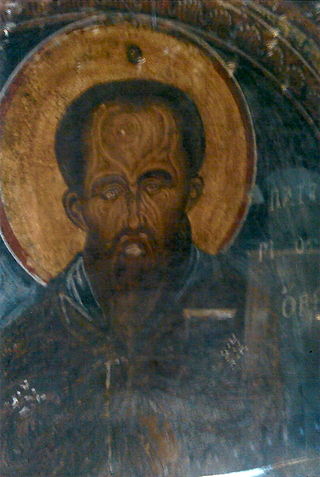
Patapios of Thebes is the patron saint of dropsy. Saint Patapios’ memory is celebrated on 8 December and also at the Tuesday 2 days after the Sunday of Easter. His relic is kept at the female monastery of Saint Patapios at Loutraki, a spa town near Athens, Greece.

Saint Demiana and the 40 Virgins was a Coptic martyr of the early fourth century.

Saint Savvas of Kalymnos is the patron saint of the Greek island of Kalymnos, where he lived during the last twenty years of his life as the priest and spiritual father of the nuns of the Convent of All Saints. He was a great ascetic, confessor, icon painter, and miracle-worker. He is one of the recently recognized saints in the Greek Orthodox Church.

The Abbey of the Holy Cross was a French Benedictine monastery of nuns founded in the 6th century. Destroyed during the French Revolution, a new monastery with the same name was built in a nearby location during the 19th century for a community of Canonesses of St. Augustine of the Mercy of Jesus.
Hunegund of France was a 7th-century French saint and nun and founder of a convent in Homblières in Northern France. She was betrothed to a French nobleman, but while visiting Rome before their marriage, she chose to become a nun instead. Hunegund built a church on the grounds of a convent in Homblières; eventually her fiancé donated everything that he would have given to her if they had married to the convent, "became her most devoted friend and servant", and took care of her and the convent's financial needs. Hunegund became abbess of the convent and was considered its founder. She died in 690; her feast day is celebrated on 25 August by the Roman Catholic Church and Orthodox Church and on 1 November by the Catholic Church in France. Hunegund's body and relics were translated to the church she founded in 946; she performed miracles and appeared in visions that solidified her cult and veneration. In the mid- and late 10th century, two hagiographic texts about the life and miracles of Hunegund were written and published to connect the community to Hunegund's relics and cult. Her body and relics were translated again, during the Hundred Years War in the late 14th century.
